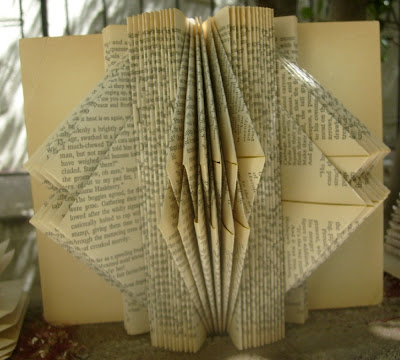
Why make art out of books?
I have always been a prolifically creative person. That means I have an obsessive need to make things, but I don't spend a lot of time on any one of these things. During college, one of my personal challenges for my art was to let myself take more than five minutes at a time to do it! Friends of mine would fiddle with one painting for what seemed like forever. I had to do a painting in a day or work on several at once, flitting from one to the next in a constant circuit.
Over the years, I have tried a multitude of crafts - that word meaning "different forms of making." I dislike the word 'craft' in that it brings to mind tole painting or sticking cartoon speech balloons to photographs. Hokey. Ill-made. Dust-catcher. In it's original form, 'craft' actually meant: make by hand and with much skill.
I've learned basket-weaving, paper-making, stained glass, bookbinding, quilting, oil painting, sculpture, welding/casting, baking, sewing and probably many other things that I just can't remember right now. One thing that has always held me back is cost. I simply can't afford to make things at the rate (and skill level I have the patience for) that I, uh, make them.
So, I mulled it over on the backburner of my mind for a long time. I needed a craft that I could make a lot of, get the supplies for readily, was "me" and I could afford.
And then Mary Engelbreit's Home Companion had an article in one of their magazines about folding books. It hit me like a bolt of lightning. I usually tear out magazine articles and hold on to them for years, never doing anything with them. Not so with this one! I found an old book and got to work that night, folding away.
It was wonderful. I had a piece of work that I was proud of in just a few hours. I love books (as evidenced by the fact that I own about a billion of them, have worked in bookstores or libraries for my whole life and consider reading to be both good for you and fun, too) and saw the potential for using old, unloved books in new and exciting ways.
So I use old books to make art. After a lot of
trial and error, using
all different sizes and shapes of books, I decided that
Reader's Digest Condensed books give me the most consistent results in what counts: number of pages, quality of paper, and size of finished piece. This is not to mention the fact that RDC Books are in great abundance (for people donate them in quantity to libraries and thrift stores), they are cheap (see previous fact), they are well-made in terms of both binding and paper quality, and, lastly, they are not valuable anymore in terms of the information they hold.
That makes them perfect.



Comments